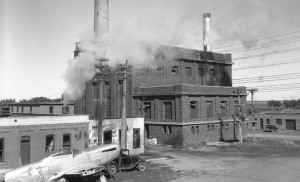In the late 1940s and early 1950s until it was unceremoniously trundled to the town dump, a WW II fighter plane was parked on the south side of SDSU’s power plant.
How that surplus P-51 Mustang fighter, arguably the best prop-driven fighter ever, ended up on the campus and then in the city’s junk pile was a mystery until I talked with Coralyn Amidon James, 89, of Brookings.
She remembered the work her father, Professor Lee Amidon, who was head of the SDSU Mechanical Engineering Department, put forth to bring the sleek craft to campus.
James is a 1946 State College grad. When I visited with her, she had a clear memory of the Sunday morning the plane arrived in Brookings.
So does her brother, John Amidon, a 1958 graduate of State now retired from GE and living in Vermont.
“We were just sitting down for breakfast when my father got back from Sioux Falls where he had picked up the plane,†she recalls. She doesn’t remember the year, but it was probably 1948 or 1949.
James says her father envisioned using the surplus war machine as a teaching tool for his mechanical engineering classes as well as to stimulate campus discussion of and interest in airplanes.
When Professor Amidon heard of the availability of a Mustang at the Sioux Falls Air Base, he inquired, and it was gifted to State College. Getting it to campus was Amidon’s problem.
First, the wings were removed in Sioux Falls. There were no trucks available to transport the big, wingless airplane, so the challenge was how to get it to campus.
Amidon decided he’d tow it from Sioux Falls to the campus behind his car. He picked early Sunday hours for the trip when traffic would be light, except for possibly some early morning revelers returning to East Men’s Hall.
Imagine the sight, after a Saturday night too long in the cups at the Lone Tree Bar or the Dell Rapids Dance Hall, or other hot spots along Highway 77, of a wingless P-51, its massive, four-bladed propeller and 1,490-horsepower engine bearing down on the tail of Amidon’s boxy little Studebaker.
Cruising at about five miles an hour in the middle of the night, the strange caravan made the 60-mile trip without incident.
It weighed more than 7,000 pounds and without a sturdy drawbar it would have caught up with Amidon’s car on the down hill. But it didn’t, and SDSU gained an air force.
Incidentally, when the Korean War started in the early 1950s, Amidon was contacted by the military. They wanted their P-51 back for Far East service. Amidon told them they could have the plane, but it had no wings.
The military recall was cancelled.
James, after that long-ago Sunday breakfast talking airplanes with her father, is often reminded of the P-51 her father towed from Sioux Falls.
From her apartment window she can see the plane’s inglorious burial grounds, which is no longer a city dump, but Larson Hill, a carefully groomed community sledding hill.









